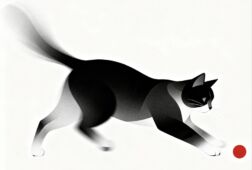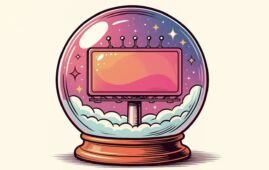Made for Ignoring: Why Optimisation Is Killing Advertising’s Soul
by Shirley Marschall on 28th May 2025 in News

Shirley Marschall examines how optimisation is affecting advertising. Have we optimised into oblivion?
Remember that banner ad that made you laugh? The pre-roll that really resonated with you (or at least didn’t make you skip immediately)? The Instagram ad you thought was cute?
Oh, you don’t? How shocking… Welcome to the MFI Era: Made for Ignoring.
Now think of the last great TV ad you saw. Easy, right?
Here’s what’s mind-blowing – despite commanding MASSIVE budgets, most digital ads are built with one thing in mind: being ignored. Not intentionally but, more often than not, creative seems to be an afterthought – generic, templated, and optimised into bland compliance with what worked last quarter. Hence: Made for Ignoring.
We’ve now reached the point where even attention is being downsized. Recent research celebrates that capturing attention takes just 1.5 seconds, down from the previously assumed 2.5. That’s fascinating and terrifying. In a world flooded with forgettable content, this isn’t a breakthrough. It’s a warning sign.
We’re designing for minimal impact, minimal disruption, minimal thought. Digital ad formats are forgettable by design. Creative is treated like filler, not a feature. And we wonder why the creative doesn’t resonate…
AI chance or sameness on autopilot?
Search was invented in the 90s.
Email? Older than most of us think, its roots go back to the 1950s.
Mobile exploded in the early 2000s.
And the iPhone, arguably the last true (advertising) revolution, turning 18 this year.
(Feeling old yet?)
These days it’s easy to believe innovation is accelerating. But maybe the astonishing thing isn’t how fast we’re moving, maybe it’s how long we’ve been stuck!
Because for all the billions poured into digital advertising since, how much has really changed? Same formats. Same KPIs. Same banner ads nobody remembers. We’ve optimized ourselves into a corner.
Now AI promises to transform advertising, but is it just speeding up sameness?
Optimisation into oblivion
Google and Microsoft made one thing crystal clear: AI isn’t the future of technology, it is THE technology.
At Google I/O, the company unveiled a wave of AI-first features, from Gemini AI embedded across its ecosystem to a new AI Mode in Search designed to make the experience more “invisible” by summarising results instead of showing links.
At Microsoft Build, the focus was on AI agents, Copilot tuning, and multi-agent orchestration – tools designed to hand over more tasks to intelligent systems that learn, scale, and act independently.
In both visions, AI is becoming deeply integrated, ambient, and automatic.
But in advertising, that poses a question we can’t afford to ignore:
If AI is everywhere – and running everything – what happens to originality?
We’ve already spent the past decade(s) optimising creative, targeting, and placements into oblivion. Now, with AI accelerating the push toward automation, we risk trading what’s distinctive for what’s efficient.
And in that world, advertising won’t just be optimised. It’ll be invisible.
Optimisation was never the goal
With the rise of AI, we’re seeing a new wave of tools that promise to make everything faster, easier, more efficient. But if optimisation becomes the only goal, creativity dies an optimised death.
Already, we’re watching this happen in real time.
AI generates variations. It tests endlessly. It tells you what converts. And it flattens everything it touches – removing friction, yes, but also sanding down a brand’s interesting edges. Instead of breakthrough ideas, we get data-confirmed déjà vu.
When everyone uses the same tools to chase the same metrics, we shouldn’t be surprised when all ads look – and feel – the same.
The creativity/scalability tradeoff
It’s easy to call for more creativity but let’s be honest: creativity doesn’t always scale.
And scale is the engine of modern advertising. AI thrives on repeatability. Platforms reward volume. Optimisation favors consistency.
There’s a real tension between being distinctive and being deployable across markets, platforms, and formats at speed.
But when scalability becomes the sole filter through which ideas are judged, the result isn’t reach, it’s sameness.
The challenge for modern marketers isn’t just to be creative. It’s to protect creativity while still operating at scale. That takes more than clever headlines or bold visuals; it requires rethinking how we use data, how we brief teams, how we define success.
At this moment, marketers face a choice
We can chase short-term gains, optimise toward sameness, and let our brands become increasingly interchangeable.
Or…we can resist!
We can remember that great advertising doesn’t just work, it moves. It provokes. It creates culture.
And this isn’t just about better ad design. It’s about rethinking the entire strategy: how we target, where we show up, and what signals we choose to value.
AI opens new doors but so does natural intelligence, if we choose to think beyond the herd.
We need brands with a point of view. With edge.
And we need marketers, strategists, and creatives with the courage to stop asking, “what’s worked before?” and start asking, “what’s worth doing now?”
Because the future of advertising shouldn’t be an automated replica of the past.
It can be smarter, more intentional, and more respectful but only if we, as an industry, demand more from ourselves:
More originality. More experimentation. More bravery.
Final thought:
In a world optimising for everything, creativity may be the last true differentiator. Let’s not lose it – or keep wasting billions on MFI.
AdvertiserAdvertisingOptimisation








Follow ExchangeWire